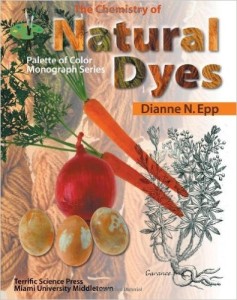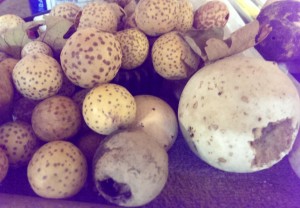Indigo is apparently the gateway drug of the natural dye world. It led me to try dyeing with cochineal, which should have led me to a better understanding of mordanting, except it didn’t. There are a lot of recipes, but not a fat lot of information out there on the science of natural dyeing. There is a lot of information on synthetic dyes. As it turns out, there is a good reason for this.
The history of synthetic dyes is also the history of organic chemistry, so the process of learning how to make synthetic dyes provided the chemical knowledge. The advent of synthetic dyes squeezed out the natural dyers’ guilds, so the new chemical knowledge wasn’t applied backward. There is a lot of good information out there on the invention of mauveine, the first analine dye. If you love history, how synthetic dyes changed the socio-economic world is fascinating, and it in part explains why there is precious little textile manufacturing still done in the US. Some of the more interesting monographs I’ve come across about the chemistry of natural dyeing are from India, Pakistan and Egypt, where there still are textile industries, and where scientists are taking another look at natural dyestuffs in order to have a more sustainable and less toxic impact on their environment. I’ve ended up learning about synthetic dyes, color chemistry, the quantum physics of color, synthetic fibers, and finally, mordanting and natural dyes.
That said, Maiwa and Turkey Red Journal are both excellent resources for natural dyeing information, including the chemistry, and they are both on the forefront of bringing the chemical knowledge back to the natural dye world.
So what is mordanting? If you are using metallic mordants, basically you are making your own acid dyes. Instead of using an acidic bath to promote ionic bonding as with synthetic acid dyes, the metal ions of the metal mordants have a similar polar effect. The mordants form covalent bonds with the color bearing compounds in the dyestuffs, which are the very strong bonds between atoms (sharing electrons in the outer shell). Since they are acid (polar) dyes, they therefore bond better with the positively charged amino acid chains (wool, silk) and poorly with cellulose (cotton, linen).
Tannic acid is a non-metal mordant, but “tannic acid” itself isn’t really a discreet chemical, but rather a broad heading under which several acids fall (which also happen to be tannins): Gallic acid, ellagic acid, and catechic acid. Most of the so-called “substantive” natural dyestuffs that require no mordanting have some form of tannic acid in them, for instance, sumac, pomegranate, fustic and cutch. Tannic acids bond well with protein fibers (think tanning hides), and also with cellulose plant materials. It also bonds well with the metal mordants, so plant fibers normally get pre-mordanted with tannic acid, and then again with the metal mordant.
I really wish I could tell you what chemical bonds are formed between tannic acids and these different fibers, but I’ve had no luck in finding scientific documentation thus far. I have to assume it’s not covalent bonding with cellulose just because fiber reactive synthetic dyes are so much more wash fast. I’m starting a natural dyeing class in October and I’m hoping to get to the bottom of this.
Nowadays aluminum acetate is available to mordant plant materials and the tannic acid step is debatable—this post and this post from Turkey Red Journal do comparisons of dyeing cotton cloth with different configurations of tannic acid/alum/aluminum acetate. Some of their considerations are cost and availability for dyers in poorer countries. Rachel does most of the cotton dyeing between the two of us, so I’m leaving it to her to take good notes on her findings.
This monograph is great in detailing the chemical structure of wool. There is a lot going on in a strand of wool, aside from the positively charged dye sites. There are other chemical bonds that give rise to it’s strength and elasticity, and these are both things that can be affected by Ph, heat, and specific properties of different metal mordants like iron or tin.
There is a time vs. temperature factor in mordanting. A lot of recipes call for simmering your wool in your mordant for an hour, but that can easily lead to felting. Heating up your mordant and letting your wool steep overnight can often produce a more thorough saturation of the fiber and therefore more even dye uptake. Mordanting can take place before, during, or after the dyeing, but if it’s done prior to adding the fiber to the dye pot, there is more control over the mordant-to-fiber ratio, and the mordant bath can continue to be reused. This becomes more important when using the more toxic of the metal mordants, tin, copper and chrome.
Older mordanting recipes called for an excess of the metal mordants to ensure good dye uptake, in part because the strength of the mordant material was not guaranteed. Now we can source mordants with guaranteed strength and purity, so we can be a lot more precise and use recipes that leave little to no extra mordant in the bath. I did some trials with cochineal earlier this summer (that’s the next blog post). Using a recipe for a weighed amount of fiber, I tested my mordant bath to see if it was actually discharged (my copper did not seem to be), by adding more fiber to the “discharged” mordant bath and then soaking it in the dye bath and seeing if the dye strikes or not. When I was done I bottled up and saved my remaining mordant bath rather than tossing it out anywhere.
Once the mordant has bonded to the fiber it’s not going anywhere, so you can use different mordanted materials in the same dye pot, which is fun and interesting because you can see the effect the different mordants have.
Some metal mordants are toxic. Chromate poisoning is particularly unpleasant. Oxalic acid, often used to shift colors as an after-mordant is toxic. Synthetic “true black” acid dye is also toxic, as it contains chromium as it’s coloring component. None of theses things belong in the groundwater, or your septic tank, or near kids, pets or livestock. Entrapment is the state wherein metal particles are trapped in the steam from a water bath, and are then able to be inhaled, so don’t mordant in your kitchen. And for that matter…
A cautionary tale: we have a large tanoak tree growing next to the abandoned well out by our barn, and as a good source of natural tannins, I checked the interwebs for what the tannin concentration should be compared to oak galls, etc, for a possible recipe. What I found was that it wasn’t a tanoak. So I used a tree identification website rather than the book with illustrations I’d used initially, and the final question on the flowchart was “do the leaves smell like almonds when crushed?” Ironically as it turns out, this reminded me of the opening lines of Love in the Time of Cholera. My tree does smells like almonds when the leaves are crushed. It’s a cherry laurel, and when you boil the leaves you get hydrogen cyanide, which Nero used to poison his enemies’ wells. So. Back to collecting gall nuts.



Pingback: The Science of Dyeing |
This book has information on tannins if you read German or can get it translated.
http://www.amazon.com/Handbuch-Naturfarbstoffe-Helmut-Schweppe/dp/3933203465/ref=sr_1_4?s=books&ie=UTF8&qid=1442319985&sr=1-4&keywords=helmut+schweppe
Diane, thanks for the tip! Given the history of dyeing in Germany, it doesn’t surprise me that they’ve got the answers I’m looking for.
When I dyed cotton, I used tannic acid before applying the aluminium acetate mordant. When I didn’t use the tannic acid it made no difference. My theory is that using tannic acid is useful if you are dyeing cotton fabric that has been treated with something. You need to remove that before you mordant.
My other observation about mordanting is I always follow a recipe ie % mordant based on weight of goods. It’s exactly as you point out that being more precise about quantities makes me feel more confident that the mordant bath is exhausted. Having said that I only use Alum and aluminium acetate which are not toxic. I’m not comfortable using and disposing of the heavy metals.
The aluminum acetate is a stand-alone mordant for cotton. You only need the tannic acid first if you are using regular alum, or another metal mordant. And you can use an iron mordant without concern of toxicity if you’re looking for an alternate color palette, it’s also considered safe.
Scouring first is incredibly important, and a whole other issue altogether. Maiwa has some good scouring recipes for cotton and wool. One thing I did neglect to mention was using a big enough pot…Use a big enough pot!! It cuts down on felting and helps with leveling too.
Leveling is a whole other blog post, but I’ll need more chemistry first.
Big pots are key. I am in the market for some. No value village or goodwill here. Boo!
Pingback: Last of the summer dyes |
Pingback: Fun with Cochineal |